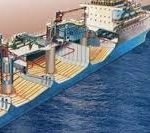Pneumatic conveying solution for LafargeHolcim Indonesia
A 1.1km pneumatic cement conveying line from Claudius Peters Projects GmbH was commissioned at the LafargeHolcim cement plant in Tuban, East Java, Indonesia. The design conveying capacity is 500t/hr. The cement is transported from a silo directly to the jetty, without any intermediate transfer points.
The project presented a number of specific challenges. The conveying system required a very high conveying capacity over a very long conveying distance; crossing a road during its first 250m over land and running in a straight line for 700m over the sea. As the pipeline has no bends, separation of the gas/solid mixture could cause material plugs in the pipeline.
In addition, the conveying line needed to be mounted properly to minimize the forces from heat expansion, whilst a loader design was needed to accommodate different ship constructions.
To come up with the best design for the conveying system, the Claudius Peters Technikum examined the material to be conveyed. As the material data gives information about the conveying gas consumption and the conveying pressure, it enabled Claudius Peters to correctly dimension the feeding device and design the pressure generator.
By means of complex calculation models, the best solution was found to be a pneumatic conveying system that uses pressure vessels as a feeding device and a pneumatic plain pipe conveyance.
Being the only company with a test conveying line of 5.1 km that can be shortened to any length, Claudius Peters was able to prove the technical feasibility of this solution to LafargeHolcim.
As a result, the completed conveying line uses two twin pressure vessel plants that operate simultaneously, each conveying 250t/h through its own pipeline of over 1.1km. With each of these plants consisting of two pressure vessels working alternately, almost continuous conveyance is ensured with a constant flow of material.
In addition, at the request of the customer, the complete conveyor pipe of each conveyance was equipped with a parallel by-pass line to allow controlled removal of plugs, should any occur. However, to date there has been no need to use this by-pass line for plug elimination. In fact, during the performance test, the pressure vessels reached a capacity of over 600 tons per hour.


